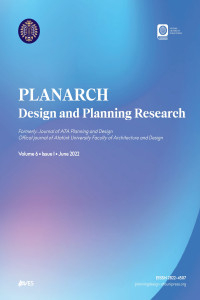İklim Değişikliği ve Yapılı Çevreler Üzerine Bibliyometrik Bir Analiz
Mimarlık, bibliyometrik analiz, iklim değişikliği, yapı bilgi teknolojisi, kentsel çalışmalar
A Bibliometric Analysis on Climate Change and Built Environments
Architecture, bibliometric analysis, climate change, construction building technology, urban studies,
___
- Aghimien, D. O., Aigbavboa, C. O., Oke, A. E., & Thwala, W. D. (2019). Mapping out research focus for robotics and automation research in construction-related studies. Journal of Engineering, Design and Technology, 18(5), 1063–1079. [CrossRef]
- Akinlolu, M., Haupt, T. C., Edwards, D. J., & Simpeh, F. (2020). A bibliometric review of the status and emerging research trends in construction safety management Technologies. International Journal of Construction Management, 1–13.
- Ali-Toudert, F., & Mayer, H. (2006). Numerical study on the effects of aspect ratio and orientation of an urban street canyon on outdoor thermal comfort in hot and dry climate. Building and Environment, 41(2), 94–108. [CrossRef]
- Baetens, R., Jelle, B. P., & Gustavsen, A. (2010). Phase change materials for building applications: A state-of-the-art review. Energy and Buildings, 42(9), 1361–1368. [CrossRef]
- Bowler, D. E., Buyung-Ali, L., Knight, T. M., & Pullin, A. S. (2010). Urban greening to cool towns and cities: A systematic review of the empirical evidence. Landscape and Urban Planning, 97(3), 147–155. [CrossRef]
- Chavarro, D., Ràfols, I., & Tang, P. (2018). To what extent is inclusion in the web of science an indicator of journal quality? Research Evaluation, 27(2), 106–118. [CrossRef]
- Damtoft, J. S., Lukasik, J., Herfort, D., Sorrentino, D., & Gartner, E. M. (2008). Sustainable development and climate change initiatives. Cement and Concrete Research, 38(2), 115–127. [CrossRef]
- Ewing, R., & Cervero, R. (2010). Travel and the built environment. Journal of the American Planning Association, 76(3), 265–294. [CrossRef] Fonseca, Bde P., Sampaio, R. B., Fonseca, M. V., & Zicker, F. (2016). Coauthorship network analysis in health research: Method and potential use. Health Research Policy and Systems, 14(1), 34. [CrossRef]
- Frontczak, M., & Wargocki, P. (2011). Literature survey on how different factors influence human comfort in indoor environments. Building and Environment, 46(4), 922–937. [CrossRef]
- Glaeser, E. L., & Kahn, M. E. (2010). The greenness of cities: Carbon dioxide emissions and urban development. Journal of Urban Economics, 67(3), 404–418. [CrossRef]
- Guo, Y. M., Huang, Z. L., Guo, J., Li, H., Guo, X. R., & Nkeli, M. J. (2019). Bibliometric analysis on smart cities research. Sustainability, 11(13), 3606 [CrossRef]
- Haddad, S., Paolini, R., Ulpiani, G., Synnefa, A., Hatvani-Kovacs, G., Garshasbi, S., Fox, J., Vasilakopoulou, K., Nield, L., & Santamouris, M. (2020). Holistic approach to assess co-benefits of local climate mitigation in a hot humid region of Australia. Scientific Reports, 10(1), 14216. [CrossRef]
- IEA (2021). Energy Efficiency. https ://ww w.iea .org/ repor ts/en ergy- efficiency -2021 .
- Li, K., Rollins, J., & Yan, E. (2018). Web of Science use in published research and review papers 1997–2017: A selective, dynamic, cross-domain, content-based analysis. Scientometrics, 115(1), 1–20. [CrossRef]
- Li, X., Wu, P., Shen, G. Q., Wang, X., & Teng, Y. (2017). Mapping the knowledge domains of Building Information Modeling (BIM): A bibliometric approach. Automation in Construction, 84, 195–206. [CrossRef]
- Lozano, S., Calzada-Infante, L., Adenso-Díaz, B., & García, S. (2019). Complex network analysis of keywords co-occurrence in the recent efficiency analysis literatüre. Scientometrics, 120(2), 609–629. [CrossRef]
- McGranahan, G., Balk, D., & Anderson, B. (2007). The rising tide: Assessing the risks of climate change and human settlements in low Elevation Coastal Zones. Environment and Urbanization, 19(1), 17–37. [CrossRef]
- Meerow, S., Newell, J. P., & Stults, M. (2016). Defining urban resilience: A review. Landscape and Urban Planning, 147, 38–49. [CrossRef] Pérez-Lombard, L., Ortiz, J., & Pout, C. (2008). A review on buildings energy consumption information. Energy and Buildings, 40(3), 394–398. [CrossRef]
- Pritchard, A. (1969). Statistical bibliography or bibliometrics. Journal of Documentation, 25(4), 348–349.
- Riehmann, P., Hanfler, M., & Froehlich, B. (2005). Interactive Sankey diagrams. IEEE Symposium on information visualization, 233–240.[CrossRef]
- Sajovic, I., Tomc, H. G., & Podgornik, B. B. (2018). Bibliometric study and mapping of a journal in the field of visualization and computer graphics. COLLNET Journal of Scientometrics and Information Management, 12(2), 263–287. [CrossRef]
- Smiraglia, R. P. (2015). Domain analysis of domain analysis for knowledge organization: Observations on an emergent methodological cluster. Knowledge Organization, 42(8), 602–614. [CrossRef]
- Van Eck, N. J., & Waltman, L. (2010). Software survey: VOSviewer, a computer program for bibliometric mapping. Scientometrics, 84(2), 523–538. [CrossRef]
- Wilby, R. L. (2008). Constructing climate change scenarios of urban heat island intensity and air quality. Environment and Planning B, 35(5), 902–919. [CrossRef]
- Wu, Z., Yang, K., Lai, X., & Antwi-Afari, M. F. (2020). A scientometric review of system dynamics applications in construction management research. Sustainability, 12(18), 7474. [CrossRef]
- Xiang, C., Wang, Y., & Liu, H. (2017). A scientometrics review on nonpoint source pollution research. Ecological Engineering, 99, 400–408. [CrossRef]
- Başlangıç: 2022
- Yayıncı: Atatürk Üniversitesi
Apartman Başlığı Altında Yazılmış Lisansüstü Tezlerin Analizi
Eleştirel Bölgeselcilik Kapsamında Ağa Han Mimarlık Ödülleri’nin Analizi
Emine YILDIZ KUYRUKÇU, Havva ÖZKAN
Covid-19 Salgını Sürecinde Kent Planlamasında Yeşil Mimari
İklim Mülteciliği ve Çözüm Önerisi Olarak Yüzen Şehirler
Güneş MUTLU AVİNÇ, Semra ARSLAN SELÇUK
Ömer Faruk BAŞGÜN, Yahya BULUT
Kırsal Turizm Odaklı Sürdürülebilir Gelişme Stratejilerinin Tespit Edilmesi: Kilistra Örneği
İç Mimarlık Programının Acil Uzaktan Eğitime Uyumlanma Süreci ve Çıkarımlar
Selver KOÇ ALTUNTAŞ, Şengül YALÇINKAYA, Erkan AYDINTAN
Cumhuriyet Dönemi Modernleşme Sürecinin Mimarlığa Etkileri: İzmit Halkevi
Değişimi Anlamak: Trabzon Gülbahar Hatun Camii ve Külliyesi
Demet YILMAZ YILDIRIM, Şeyma BAYRAM
İklim Değişikliği ve Yapılı Çevreler Üzerine Bibliyometrik Bir Analiz
